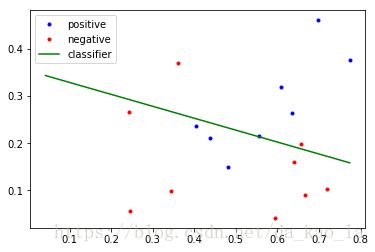周志华《机器学习》Ch3. 线性模型:对数几率回归的python实现
理论
“对数几率模型”就是常说的Logistic回归,是一个经典的线性模型。考虑二分类任务,其输出标记![]() ,而线性回归模型产生的预测值
,而线性回归模型产生的预测值![]() 是连续分布的实数,需要一个阶跃函数
是连续分布的实数,需要一个阶跃函数![]() 将连续值映射为离散二值。用一个对数几率函数
将连续值映射为离散二值。用一个对数几率函数![]() 近似阶跃函数,得到
近似阶跃函数,得到![]() 。从而y和1-y可以分别视为类后验概率
。从而y和1-y可以分别视为类后验概率![]() 和
和![]() ,简记为
,简记为![]() 和
和![]() 。
。
训练时,用极大似然法估计模型参数![]() 和
和![]() . 对给定的数据集
. 对给定的数据集![]() ,对数几率模型最大化对数似然函数
,对数几率模型最大化对数似然函数![]() . 令
. 令![]() ,
, ![]() , 似然函数可重写为
, 似然函数可重写为![]() .
.
上述似然函数可以用经典的优化算法如梯度下降法、牛顿法求解。以牛顿法为例,其第t+1轮迭代解的更新公式为![]() , 其中
, 其中 ,
,  .
.
代码
# -*- coding: utf-8 -*-
"""
Logistic Regression
From 'Machine Learning, Zhihua Zhou'
Model: P69 problem 3.3
linear model
Newton Method
Dataset: P89 watermelon_3.0a (watermelon_3.0a.npy)
@author: weiyx15
"""
import numpy as np
import matplotlib.pyplot as plt
class Logistic:
def load_data(self, filename):
dic = np.load(filename)
self.x = dic['arr_0']
self.y = dic['arr_1']
self.m = self.x.shape[0]
self.d = self.x.shape[1]
def plot_data(self):
x1 = self.x[np.where(self.y==1),:]
x1 = x1.reshape((x1.shape[1], x1.shape[2]))
x0 = self.x[np.where(self.y==0),:]
x0 = x0.reshape((x0.shape[1], x0.shape[2]))
plt.plot(x1[:,0], x1[:,1], 'b.')
plt.plot(x0[:,0], x0[:,1], 'r.')
x0min = x0.min()
x1min = x1.min()
xmin = min(x0min, x1min)
x0max = x0.max()
x1max = x1.max()
xmax = max(x0max, x1max)
xs = np.linspace(xmin, xmax, 100)
beta = self.beta.reshape((self.beta.shape[1],))
ys = -beta[0]/beta[1]*xs - beta[2]/beta[1]
plt.plot(xs, ys, 'g')
plt.legend(['positive', 'negative', 'classifier'])
def __init__(self):
self.load_data('watermelon_3.0a.npz')
def calculate_derivative(self, beta):
pLpB = np.zeros((self.d+1,))
pLpB2 = np.zeros((self.d+1, self.d+1))
pLpB2 = np.mat(pLpB2)
ones = np.ones((self.m,1))
x1 = np.concatenate((self.x, ones), axis=1)
for i in range(self.m):
myexp = np.exp(np.dot(beta, x1[i]))
p1 = myexp / (1+myexp)
x1i = np.mat(x1[i])
pLpB = pLpB - (self.y[i] - p1)*x1[i]
addi = np.dot(x1i.T, x1i)
addi = np.multiply(addi, p1*(1-p1))
pLpB2 = pLpB2 + addi
return pLpB, pLpB2
def train(self):
self.beta = np.ones((self.d+1,))
p_beta = np.zeros((self.d+1,))
while np.linalg.norm(self.beta-p_beta) > 1e-3:
p_beta = self.beta
pLpB, pLpB2 = self.calculate_derivative(p_beta)
self.beta = p_beta - np.dot(pLpB2.I, pLpB).getA()
def classify(self, xt):
xt.append(1)
xt = np.array(xt)
myexp = np.exp(np.dot(self.beta.reshape((self.beta.size,)), xt))
p1 = myexp / (1+myexp)
if p1 > .5:
return 1
else:
return 0
if __name__ == '__main__':
lg = Logistic()
lg.train()
ans = lg.classify([.555, .354])
lg.plot_data()